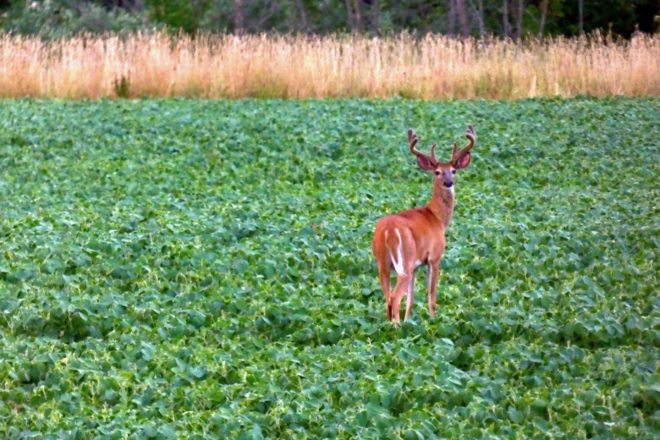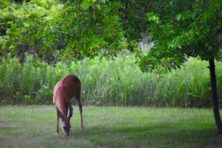Wild Things: First Hunting Seasons Knocking on the Door
- Share
- Tweet
- Pin
- Share

There’s still time for beginners to get started
by KEVIN NAZE, [email protected]
Wisconsin hunters who like their fast food on the wild side can begin the quest for frequent fliers Sept. 1: the opening day of the early goose, teal and mourning dove seasons.
Migratory birds attract a small percentage of the state’s 800,000 or so hunters, but a much larger group of venison lovers has been scouting all summer in anticipation of the archery and crossbow deer opener Sept. 17. This year’s archery and crossbow deer hunt will run through Jan. 8 in Door County, and Jan. 31 in Kewaunee County, where the County Deer Advisory Council opted for the extended hunt. Door County’s council initially recommended it but then changed its vote during the final spring meeting.
Sept. 17 is also opening day for the wild turkey, gray and fox squirrel, Northern Zone cottontail rabbit, and Zone A ruffed grouse seasons, and the youth waterfowl hunt weekend is Sept. 17-18.
The early teal season runs nine days, and the early goose season – and its generous, five-bird daily bag designed to knock back booming populations of locally raised geese – is 15 days long. The regular goose hunt opens Sept. 16. There’s a three-bird daily bag for most of it, but a five-bird bag will return for the Southern Zone’s holiday hunt Dec. 18 – Jan. 3.
The youth gun deer hunt is Oct. 8-9 this year, followed a week later by the pheasant, Hungarian partridge and Southern Zone cottontail rabbit openers Oct. 15 at 9 am.
Other Oct. 15 openers include the Zone B ruffed grouse hunt, Open Water Duck Zone, and fox, bobcat (with permit) and raccoon hunting (for residents). Nonresident raccoon hunting opens Oct. 29. Coyote hunting is open year-round.
Those who were lucky enough to draw black bear permits may begin Sept. 7. Meanwhile, the Northern Zone duck season runs Sept. 24 – Nov. 22, and the Southern Zone splits from Oct. 1-9 and Oct. 15 – Dec. 4.
This year’s regular gun deer hunt is set for Nov. 19-27, followed by the muzzleloader deer season (and extended Metro Zone gun hunt, where allowed) Nov. 28 – Dec. 7. Antlerless-only gun deer hunts will be held Dec. 8-11 statewide, and in limited areas (including Door and Kewaunee counties) Dec. 24 – Jan. 1.
Many nuisance species can be shot year-round, including starling, English (house) sparrow, opossum, skunk, woodchuck and porcupine. Landowners and family members may also hunt or trap on their own property year-round for rabbit, squirrel, fox, raccoon, woodchuck, beaver and coyote.
Learn to Hunt
The Department of Natural Resources (DNR) is hosting the second of several educational hunting webinars Aug. 31, 7 pm, for members of the public who are new to or curious about hunting. This new series is available courtesy of a partnership with Becoming an Outdoorswoman, the National Wild Turkey Federation and Pheasants Forever.
Guest speakers will share their experiences getting started in hunting and discuss common challenges faced by those who are new to hunting, fishing or trapping. Wednesday’s webinar, “Wanna Go Hunting: What Can We Hunt?,” will cover a wide variety of hunting opportunities and the basic equipment needed to get started.
Bob Nack, supervisor of the DNR’s Recruitment, Retention and Reactivation Team, said Wisconsin is home to many wildlife species that provide a sustainable source of food, fur and feathers.
“Regulated management of these species ensures their populations will continue to thrive in the future,” Nack said.
Tune in to the webinar at youtube.com/watch?v=WdejnOkO9ec, or watch a recording on YouTube anytime using the same link.
Get More Information Online
Adults and youth who haven’t completed hunter or trapper education may still hunt or trap through the DNR’s Mentored Hunting and Trapping Programs. In addition, youth younger than 16 may trap without a license when they’re supervised by a licensed trapper.
Youth 11 and younger, first-time hunters and those who have not hunted during the preceding 10 years are eligible to purchase hunting licenses at a reduced fee. Resident hunters who recruit three first-time hunters, trappers or anglers are also eligible for reduced fees.
There’s a wealth of information available at dnr.wisconsin.gov/topic/Hunt. From there, you can find links for details about mentored hunting, hunter education and safety-skills classes, license purchases, and regulations.
Stocking Meeting Tuesday
The latest state and federal Lake Michigan fisheries research will be shared, and public input on salmon and trout stocking will be taken, during a meeting Aug. 30, 6-9 pm, at Lakeshore Technical College’s Centennial Hall West in Cleveland, located between Manitowoc and Sheboygan east of I-43.
Anyone may attend in person, or online via Zoom. Find out more, including a link to register in advance, at dnr.wisconsin.gov/topic/Fishing/lakemichigan/LakeMichiganSalmonandTroutMeetings.html.
Weekly Water Levels
As of Aug. 19, Lake Michigan water levels were down two inches during the past month, nine inches during the past year and 26 inches from the monthly record, set in 2020. Lake levels were still 39 inches above the record monthly low, set in 1964, and seven inches above the 100-year average.


